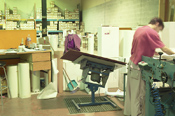
|
|
What is production leveling?

Production leveling, which is also referred to as production smoothing or heijunka (Japanese term), is the technique that was discovered by the Toyota Production System that is used to reduce the amount of waste in the production system so that your company can improve their production efficiency. More often than not, you see production leveling being used in lean manufacturing. The basic idea of production leveling is to produce goods at a constant rate so that you can allow further processing to be carried out at a constant and predictable rate.
Ideally, production can easily be leveled where demand is constant, but what happens in the real world is that the actual customer demand fluctuates. To deal with the customer fluctuations two approaches have been adopted in lean manufacturing, which are demand leveling and production leveling. These approaches have been adopted to help prevent the fluctuations in production, which is done by trying to keep fluctuation in the final assembly line to zero. How production leveling works in manufacturing is that you are never doing the same product repeatedly, as you would do with mass production. Instead, you use small batches of products. For example, Toyota never assembles the same model of car in a batch. How Toyota works is production is leveled by making first one model, then another, etc until the batch is completed. With production leveling, it can refer to leveling by volume or leveling by product mix or type.
|
|
Here are the steps you will need to take to implement production leveling in your manufacturing plant.
Step one:
Implement Green stream/Red stream, which can also be referred to as fixed sequence, fixed volume. You implement this so that you can establish the entry and exit criteria for products from the streams and you use it to establish the supporting disciplines in the support services. When you are establishing this cycle keep in mind that the established cycle will produce Every Product Every Cycle (EPEC), which is a specific form of Fixed Repeating Schedule. Green stream products are the ones with predictable demand and red stream products are high valued products that have unpredictable demands.
Step two:
Faster fixed sequence with fixed volume. This is done so that you can keep the streams the same, but use the established familiarity with the streams to maximize learning and improve production speed. Doing this will allow the shortening of the EPEC cycle so that your manufacturing plant is now producing products every two weeks instead of every month and then later on repeating every week. You might also need support services to speed up this process.
Step three:
Fixed sequence with unfixed volume. This will help to keep the stream of sequences the same, but it will also allow you to phase in actual sales to influence the volumes within that sequence. Doing this is going to affect the inbound components and the support services. It is often looked at as a generalized form of the Fixed Repeating Schedule.
Step four:
Unfixed sequence with fixed volume. This is where you are going to need to stream the sequences and EPEC. Doing this will allow the stream to be gradually flexed and it is where you are going to have to move the production line to small fixed batches to make it more manageable.
Step five:
In fixed sequence with unfixed volume. This is where you are going to be able to finally move to true single piece flow. Doing this is going to allow you to reduce your batch sizes until they reach one, which is the ultimate goal for all manufacturing plants using this system.
Privacy Policy, Terms of Use